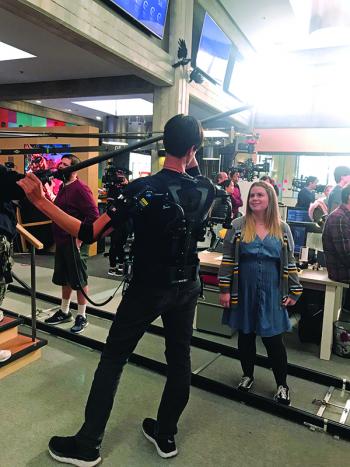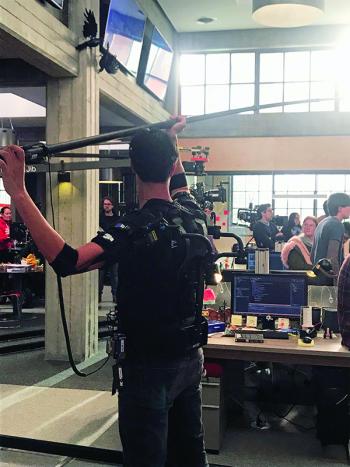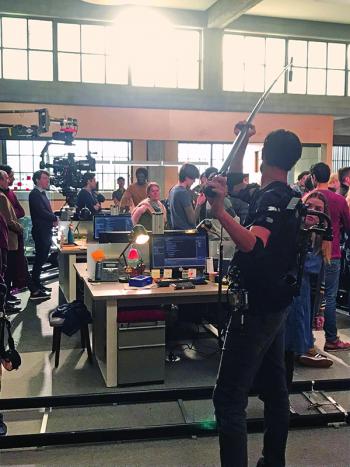Using an Exoskeleton in Real-World Settings
by Ken Strain and Bryan Cahill

As Bryan Cahill wrote in the 2019 spring edition of Production Sound & Video, Brandon Frees, Ekso Bionics VP of Sales, provided him with a loaner EksoVest, thus allowing working Microphone Boom Operators to give it a test drive in real-world conditions for a week or two at a time. As part of that trial, Ken Strain and Corey Woods were able to use the vest on the Apple TV+ series Mythic Quest. Bryan then brought the vest to Mike Anderson on Goliath.
In this article, Ken, Corey and Mike share their thoughts about using the vest on actual shoots.
Ken Strain: I’m six feet, five inches tall so, I tend to hold my arms over my head less than shorter boom ops, as I favor keeping the boom at shoulder level and resting my elbow on my hips for long takes. On this new comedy however, there are many resets and pickups of alt lines, and we get into very long takes. I often find myself having to hold the boom overhead for 15 to 30 minutes, in order to get around practical lights and reflections. So I jumped at the chance to give this vest a try to see if it would help.
This vest was not made for our industry. It is designed for the automotive industry where the line workers raise and lower their arms with tools thousands of times per day, and wear the vest all day long. It’s built for that type of intense daily usage, with very strong joints and bearings. The autoworkers work in their own stations, with clear space all around them, so the elbows (link assemblies) that stick out in the back are not an issue like they are for us on cramped film sets.
The vest can be set up for various body types, and I’m sharing it with my Second Boom, Corey Woods, who is around five feet, eight inches tall. He tends to hold his arms overhead more often than I do, and he has shoulder issues, which makes it more difficult for him to boom. I do my best to keep him off the stick, but we are an ensemble comedy, so he has to work on many slots.
The vest has four spring options, and we are using the strongest spring, labeled “4,” which gives about fifteen pounds of upward assistance once your elbow reaches a horizontal height. When at rest with arms by your side, the system is not engaged. The buckles and straps that attach around the bicep part of the body are comfortable and easy to use. The angle of assistance can be tweaked as well, to provide the max assistance at a higher engagement point if you happen to reach higher normally.
Ours is set up neutral, so its “shelf” of support is right at shoulder level. I only engage the spring in the leading arm, and keep the trailing arm turned off, so that my arm and the vest itself acts as the counterweight, and it works great this way. It is very easy to lean against the back of the vest, with your arms overhead holding and guiding the boom pole. It looks like work, but instead of the forces going into the shoulders, they are routed down to the hip belt. So all you do is guide the pole, and the nasty heaviness of it is painlessly transferred to your hips. It’s a great feeling when the situation is right.
I tried it on several different types of shots, the first was a crane shot that was just wildly shooting around the room. That was just to get the feel of it, as it wasn’t a major dialog scene. This is where I figured out the max length of boom pole extension before it overwhelms the spring. For my particular setup, that was an 18 foot K-Tek boom pole with internal coiled cable and a CMIT mic on a PSC mount, extended one half section short of full extension. My setup is already well balanced, if you are using a plug-on transmitter on the mic end, you’ll have less extension for sure. If you were to use this outside with a zeppelin, then you will only have assistance, not complete support unless you’re on a relatively short pole.

“Walking backward while booming is a very dynamic situation, and having the assistance change while I was sort of bouncing around behind camera made for an awkward feel.” –Ken Strain
The next shot was a fairly straightforward Steadicam walk and talk through our bullpen, and that did not work so well for me. Walking backward while booming is a very dynamic situation, and having the assistance change while I was sort of bouncing around behind camera made for an awkward feel; the spring engaging on and off unnaturally. Also, the way the vest fits snug around the hips makes it feel as if it is not designed for backpedaling. I didn’t feel free or comfortable. When I mentioned this to Bryan Cahill, he suggested I might try less assistance or lighter springs which I’ll try if I get another opportunity.In general, Steadicam walk and talks don’t tend to be ridiculously long with endless resets, as everyone seems to be aware of the Steadicam Op’s fatigue. And, I think you run a higher risk of hitting something with this vest on a walk and talk which would be a total party foul.

My next opportunity was exactly what I envisioned the vest to be for: a three-page dialog scene among six actors in a conference room. I had to keep the boom working over a long LED practical that hangs over the table. There was no other way to pull this off without having my arms overhead. I also had to stay mobile because the three cameras were doing moves on the dance floor around me and my actor had a back-and- forth move that went deep. Since I couldn’t use a ladder, this was the perfect scenario for the vest.
I had ample space behind me to allow for the link assemblies that stick out from the vest. It worked like a charm. I had total mobility like normal, yet my arm was completely supported at the elbow. I did notice over the duration of the take, that support would start to sag a little, meaning I was right at the limit of full support for this spring. I could have used less pole and experienced less sag over time. Basically, the spring needs to be stronger. For autoworkers, they don’t need a super strong spring to provide a continuous solid shelf of support, so this is one limitation that needs to be overcome. EksoVest is prototyping a stronger, number “5” spring which could solve the problem.
The other limitation is the most obvious one, and that is the space it takes up behind the back. You need to place yourself carefully on the set to avoid hitting anything or anyone. It alters the decision making of where you place your self or even walking around the set, you need to be conscious of your space. It definitely makes you feel like Robocop, and that’s exactly what people on set were calling the vest (it does draw an enormous amount of attention and curious questions). The articulating link assemblies limit you to working only in areas which have at least an extra eight inches free behind you. This is a deal killer if someone needed to use the vest all of the time.
One advantage of this design over the Shoulder X vest, which has a much trimmer back profile, is that this system of articulating link assemblies behind the back does not interfere with your arms and shoulders when you find yourself raising your arms straight up. There is nothing above your shoulders, like the Shoulder X, which has a frame that hinges a few inches above the shoulder. This is how they get around the problem of maintaining a tight profile. When I tried that vest on at our union meeting, it felt great until I raised my arms straight up, and basically contacted the metal frame, and it felt like now I was fighting it. Other than THAT, it seems really well designed. As Boom Operators, we have some pretty specific and unique requirements, and exoskeleton manufacturers are going to have their hands full designing something that works with our range of motion and in the tight quarters that we find ourselves. I’m sure it will be possible.
The EksoVest feels good and very high quality. The new stronger spring will be a welcome addition. The stronger the better, but not so strong that we can’t bring our arm back down!
Corey Woods: I concur with everything that Ken wrote. I would only add that the level of adjustment is quick and the ease of putting the suit on when needed can be as quick as thirty seconds. We don’t always need the vest, but when we do, it might be at the last minute. A consideration for Boom Operators who find it hard to leave the set for fear of missing a rehearsal, lighting change, etc.
Mike Anderson: Recently, I had the opportunity to try one of the exoskeletons being tested for use by microphone Boom Operators. The EksoVest exoskeleton system was loaned to me by for a ten-day stretch during production of the third season of Goliath, the Amazon series. Once Bryan Cahill gave me a quick run-through of how the vest works and we got it fitted, I put it to the test.
I found it had a surprisingly comfortable fit coupled with a very good range of motion. The vest has interchangeable springs that add and/or reduce the vest’s lifting power. I started with the heaviest load lift thinking, “Hey, why not?” Once I really started to get used to it, I found myself almost fighting it.
When I switched the springs to a lower lift tension, I found the lower tension made all the difference and the system was extremely helpful. I suggest everyone booming give it a try. It can’t hurt, literally! I want to thank Bryan for all of the work he has done trying to find ways for us Fishpole Boom Operators to minimize the abuse we do to our bodies on a daily basis. If you think I’m wrong, you are kidding yourself. Maybe we can make these devices a standard on set. After all, when was the last set you were on where the camera operators didn’t have an Easy Rig on standby?